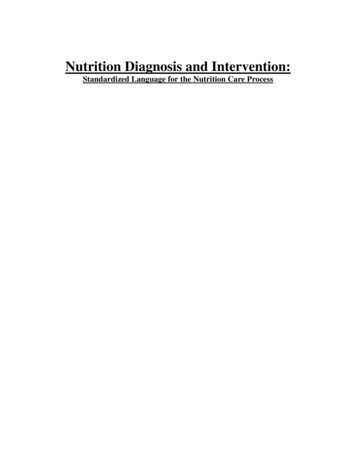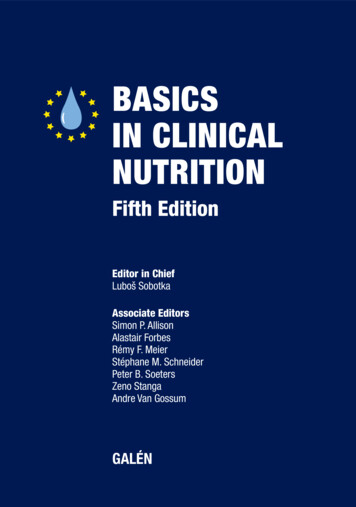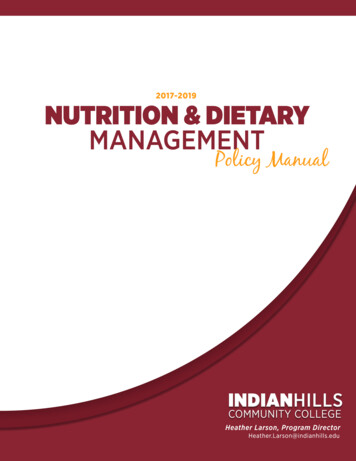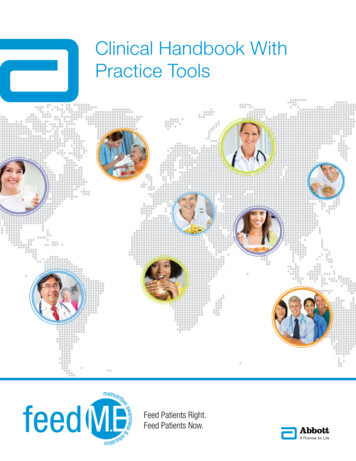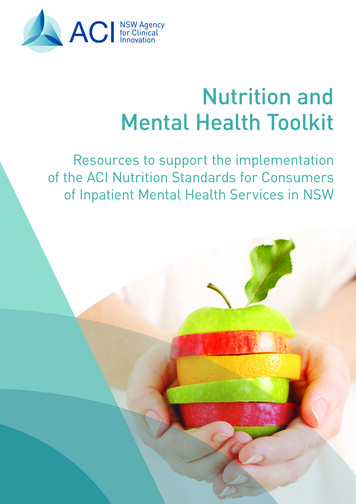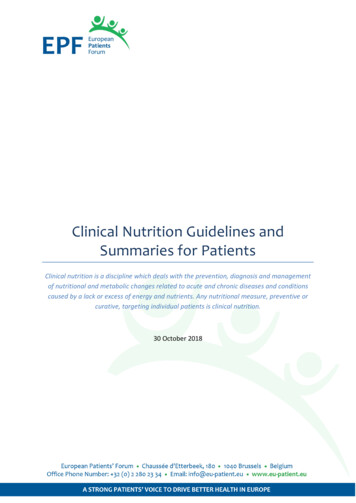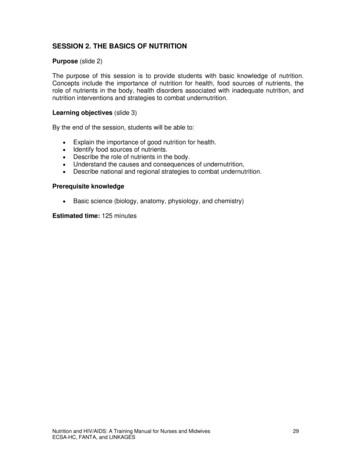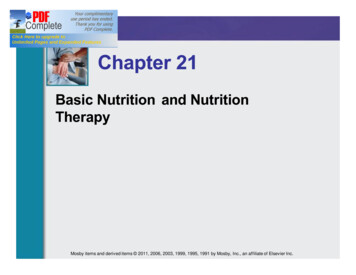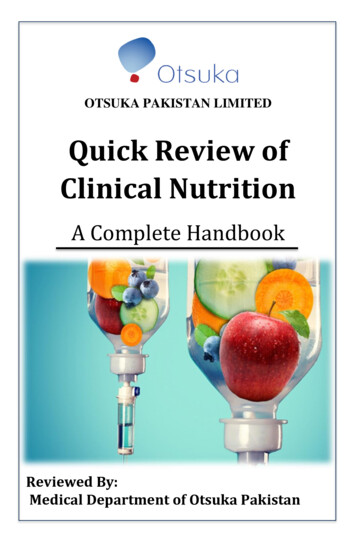
Transcription
OTSUKA PAKISTAN LIMITEDQuick Review ofClinical NutritionA Complete HandbookReviewed By:Medical Department of Otsuka Pakistan
PrefaceMalnutrition in all its forms remains a global concern, particularlyaffecting highly vulnerable populations in several regions of the world.Ambitious global targets and sustainable development goals have beenset to address this problem. The UN General Assembly declared on April1, 2016, the UN Decade of Action on Nutrition for the period 2016–2025.The Decade of Action reaffirms the call to end all forms ofmalnutrition as anchored in the ICN2 (The Second InternationalConference on Nutrition) Rome Declaration and in the 2030 Agenda forSustainable Development. It provides a unique avenue for a sustainedglobal push on nutrition.Dietary factors have been implicated in at least four of the ten leadingcauses of death (heart disease, cancer, diabetes, and stroke).Nevertheless, physicians frequently receive inadequate training innutrition to properly counsel their patientsAnyone interested in providing optimal nutrition support to theirpatients knows that it is essential that knowledge, judgment,proficiency, and competency must prevail in choosing the best nutrientconstituents of a feeding regimen and in deciding how theseformulations might best be provided for the maximal benefit and safetyof the patient under virtually any condition or in any adverse situation.Not to have knowledge, experience, or proficiency with every tool in ourclinical tool box detracts from our education and training; our trust,competence, and professionalism; and our morals, ethics, andobligations.Practitioners who always treat their patients with enteral nutrition andthose who always treat their patients with parenteral nutrition are bothlikely to be practicing less than optimal nutrition support. The mostappropriate feeding modality in every conceivable clinical situationrequires extensive versatility, experience, judgment, proficiency,wisdom, and equanimity. It bodes well for practitioners of nutritionsupport to appraise a given clinical situation comprehensively in orderto identify and define the goals of nutrition support, and to choose anduse the most appropriate nutrition support tools proficiently in theoverall comprehensive management of the patient.2
A primary goal of this text is to provide with information backed bynutritional science, and with a variety of resources that use scientificevidence to optimize health and prevent disease. There are manyconditions and deadly diseases that can be prevented by good nutrition.This book will facilitate the medical students, general practitioners,interns, dieticians, nurses, pharmacists and all others who areassociated with the medical profession on daily basis to find the answersto their questions and enhance use of nutrition care in their dailypractices. However, this booklet is not a substitute for the standardtextbooks and references should be made to them, wheneverappropriate.Medical DepartmentOtsuka Pakistan Limited2nd February 20193
Table of ContentsSection I:Nutrients and MetabolismChapter 1:Overview of NutritionChapter 2:Body CompositionChapter 3:Classification of NutrientsChapter 4:Functional Anatomy of GITChapter 5:Carbohydrates and their ImportanceChapter 6:Lipids and their RoleChapter 7:Proteins in NutritionChapter 8:Vitamins, Minerals and PhytochemicalsChapter 9:Fluids and Electrolytes in Human NutritionChapter 10:Malnutrition RevisitedChapter 11:Nutrition and Energy MetabolismSection II:Nutrition and LifecycleChapter 12:Nutrition in PregnancyChapter 13:Nutrition in ChildrenChapter 14:Nutrition in AdultsChapter 15:Nutrition in ElderlySection III:Nutrition in Disease StatesChapter 16:Metabolic Response to Trauma and SurgeryChapter 17: Nutrition, Infection and immunityChapter 18:Nutritional Metabolism in Chronic Liver4
Chapter 19:Nutritional Aspects in OncologyChapter 20:Disease Nutrition in Renal FailureChapter 21:Nutrition in Burn PatientsSection IV:Nutritional Assessment and SupportChapter 22:Nutritional Evaluation and ScreeningChapter 23:Assessment of Nutritional RequirementsChapter 24:Types of Nutrition SupportSection V:Total Parenteral Nutrition - TPNChapter 25:A Review to PNChapter 26:PN via Venous AccessChapter 27:PN RequirementsChapter 28: PN ComplicationsOtsuka EN ProductsOtsuka PN ProductsAppendixBibliography5
Section I: Nutrients and MetabolismChapter 1:Overview of NutritionNutrition is a young science. A science that studies nutrients and othersubstances in foods and in the body and the way those nutrients relate tohealth and disease. Nutrients are the nourishing substances in food thatprovide energy and promote the growth and maintenance of the body. Inaddition, nutrients aid in regulating body processes such as heart rate anddigestion and in supporting the body’s optimum health. Diet is the food andbeverages you normally eat and drink.Our choice of diet strongly influences whether we will get certain diseases,such as heart disease, cancer, and stroke—the three biggest killers aroundthe Globe. Indeed, high costs are associated with poor eating patterns. In2014, the Centers for Disease Control and Prevention observed thatdiseases like heart disease and stroke around the Globe are among the top5 causes of Deaths. Such diseases are associated with Bad eating habit. Nodoubt eating right contributes to health and quality of life, and this isreflected in growing consumer awareness of eating healthy.Characteristics of a nutritious dietA nutritious diet has four characteristics:1. ADEQUATE DIET- A diet that provides enough energy, essentialnutrients, and fiber to keep a person healthy.2. MODERATE DIET- A diet that avoids excessive amounts of energy orany particular food or nutrient.3. BALANCED DIET- A diet in which foods are chosen to provide energy,essential nutrients, and fiber in the right proportions.4. VARIED DIET- A diet in which you eat a wide selection of foods to getnecessary nutrients.You’ve heard the term “nutrition” all your life. The food-fitness connectionis what it’s all about. In a nutshell, nutrition is how food nourishes yourbody. The intake of food you choose to eat determine which nutrients yourbody will receive and in what quantities, considered in relation to thebody’s dietary needs.6
Today, we define nutrition as the sum of all processes involved in howorganisms obtain nutrients, metabolize them, and use them to support allof life’s processes.The investigation of how an organism is nourished, and how nourishmentaffects personal health, population health, and planetary health is calledNutritional Science.Today, nutrition advice, with the consensus of nutrition experts, issupported by solid scientific evidence. So unlike the ancients, you have avalid basis for choosing food for health. It’s up to you to apply nutritionprinciples and advice for your own well-being.7
Chapter 2:Body CompositionThe human body is made up of different types of tissues including muscles,bones, fats and organs. The total percentage of these tissues describes thetotal composition of your body. Various factors involves to this bodycomposition are heredity, age, healthy lifestyles (such as physical activityand eating habits) and maturation. Many of these factors are uncontrollablebut two factors that can be controlled are physical activity and nutrition.Body composition refers to the division of total body weight (mass) intocomponents; most commonly fat mass and fat-free mass. The proportion oftotal body weight that is fat (referred to as percent body fat) is animportant health-related indicator because high levels of body fatness areassociated with increased risk of coronary heart disease, stroke, anddiabetes.Body fat is one important component of the body composition. Neither toomuch nor too less body fat is of benefit to the human body composition.The ideal situation is to be in the healthy fitness zone for body fatness.Essential fat is the minimum amount of fat necessary for good health. Fat isstored in the form of energy which can be utilized for the provision of fuelto carry out necessary physical activities. This source of energy is useful incase of longer starvation periods.Body composition includes more than just muscle and fat; it also includesbones, organs, tendons and ligaments. Health wise, body compositiontypically measures body fat vs. lean body mass. Lean body mass not onlyincludes your muscle but also organs, bones, tendons and ligaments. Thereare a number of tools used to measure body fat, including calipers,bioelectric impedance and underwater weighing. But according to StevenHeymsfield, author of "Human Body Composition," muscle mass testing islimited and based on cadaver dissection studies. While you may be able todetermine your exact body fat percentage, determining your muscle mass isa little less precise.Estimating Muscle MassWhen determining muscle mass, you want to know how much skeletalmuscle you have, and this includes those muscles you're working out at the8
gym. According to Heymsfield, 30 to 40 percent of a healthy person's bodymass is made up of skeletal muscle. A study from 2000 published in theJournal of Applied Physiology found through whole body MRI testing thatwomen tend to have less muscle mass, closer to 30 percent of their bodyweights, than men, who have closer to 40 percent. Based on thisinformation, a 200-pound man has about 80 pounds of muscle mass.Muscle mass is not the same for everyone, however, and may varydepending on age and fitness level. The amount of muscle you have in yourbody, according to the authors of the 2000 study in the Journal of AppliedPhysiology, decreases as you age and dramatically after age 45. Andaccording to a classic study in the Journal of Sports Sciences, fitness andtype of activity make a difference in muscle mass, with bodybuilders havinga greater percentage of muscle than endurance athletes.Body Fat and Its DistributionWater, organs, bone tissue, fat, and muscle tissue make up a person’sweight. Having more fat mass may be indicative of disease risk, but fat massalso varies with sex, age, and physical activity level. Females have more fatmass, which is needed for reproduction and, in part, is a consequence ofdifferent levels of hormones. The optimal fat content of a female isbetween 20 and 30 percent of her total weight and for a male is between12 and 20 percent.Methods to measure Fat massFat mass can be measured in a variety of ways. The simplest and lowestcost way is the skin-fold test. A health professional uses a caliper tomeasure the thickness of skin on the back, arm, and other parts of the bodyand compares it to standards to assess body fatness. It is a noninvasive andfairly accurate method of measuring fat mass. Other methods of measuringfat mass are more expensive and more technically challenging. Theyinclude: Underwater weighing - This technique requires a chamber full of waterbig enough for the whole body can fit in. First, a person is weighedoutside the chamber and then weighed again while immersed in water.Bone and muscle weigh more than water, but fat does not—therefore9
a person with a higher muscle and bone mass will weigh more when inwater than a person with less bone and muscle mass.Bioelectric Impedance Analysis (BIA) - This device is based on the factthat fat slows down the passage of electricity through the body. Whena small amount of electricity is passed through the body, the rate atwhich it travels is used to determine body composition. These devicesare also sold for home use and commonly called body compositionscales.Dual-energy x-ray absorptiometry - This technique can be used tomeasure bone density. It also can determine fat content via the samemethod, which directs two low-dose x-ray beams through the body anddetermines the amount of the energy absorbed from the beams. Theamount of energy absorbed is dependent on the body’s content ofbone, lean tissue mass, and fat mass. Using standard mathematicalformulas, fat content can be accurately estimated.Body mass index (BMI) is calculated using height and weight measurementsand is more predictive of body fatness than weight alone. BMImeasurements are used to indicate whether an individual may beunderweight, overweight or obese. High BMI measurements can bewarning signs of health hazards ahead, such as cardiovascular disease, Type2 diabetes, and other chronic diseases. BMI-associated health risks vary byrace. Asians face greater health risks for the same BMI than Caucasians, andCaucasians face greater health risks for the same BMI than AfricanAmericans.To calculate your BMI, multiply your weight in pounds by 703 (conversionfactor for converting to metric units) and then divide the product by yourheight in inches, squared.10
BMI [weight (lb) x 703] height (in)2OrBMI [weight (kg)] height (m)2CategoriesBMIUnderweight 18.5Normal weight18.5–24.9Overweight25–29.9Obese 30.011
Chapter 3:Classification of NutrientsNutrients are categorized into two major groups: Macronutrients andMicronutrientsMacronutrientsNutrients needed in larger quantities (in grams) are called Macronutrients.These include carbohydrates, fat and proteins. Macronutrients are alsoknown as energy-providing nutrients. Energy is measured in calories. It isrequired for the body to grow, repair and develop new tissues, conductnerve impulses and regulate life process.MicronutrientsMicronutrients are nutrients that are required by the body in minutequantity. These include minerals and vitamins. Both micro and macronutrients are extremely significant to perform the basic functions of thebody. Their key function is to facilitate the chemical reactions in the body.Micronutrients do not fulfill the function of energy.Water is not classified as a macronutrient or micronutrient, but is essentialfor health and life. Water makes up a large part of our body weight and isthe main component of our body fluids. The body needs more water everyday than any other nutrient. Water carries nutrients throughout the body,provides lubricants and cushions for the joints and the eyes, eliminateswastes, and helps maintain body temperature and regulate many bodyprocesses. We lose water every day and our bodies do not store extrawater, so we need to replenish water through the foods and liquids we eatand drink.The energy nutrients are carbohydrate, protein, and fat; the non-energynutrients are water, vitamins, and minerals.12
NutrientPrimary FunctionsProteinBuilds new tissues, antibodies, enzymes, hormones, andother compoundsCarbohydrateProvides energyFatProvides long-term energy, insulation and protectionVitaminsFacilitate use of other nutrients; involved in regulatinggrowth and manufacturing hormonesMineralsHelp build bones and teeth; aid in muscle function andnervous system activity13
Chapter 4:Functional Anatomy of GITDigestionDigestion is the process by which food is broken down into molecules thatare small enough to be absorbed into the circulation.E.g. Ingested proteins are first reduced to polypeptides and then furtherdegraded to small peptides and amino acids that can be absorbed.Digestive ProcessesThe activities in the digestive system can be grouped under five mainheadings: IngestionPropulsionDigestionAbsorption Defecation14
The first of these processes, ingestion, refers to the entry of food into thealimentary canal through the mouth. There, the food is chewed and mixedwith saliva, which contains enzymes that begin breaking down thecarbohydrates in the food plus some lipid digestion via lingual lipase.Chewing increases the surface area of the food and allows an appropriatelysized bolus to be produced.Food leaves the mouth when the tongue and pharyngeal muscles propel itinto the esophagus. This act of swallowing, the last voluntary act untildefecation, is an example of propulsion, which refers to the movement offood through the digestive tract. It includes both the voluntary process ofswallowing and the involuntary process of peristalsis. Peristalsis consists ofsequential, alternating waves of contraction and relaxation of alimentarywall smooth muscles, which act to propel food along. These waves also playa role in mixing food with digestive juices.Digestion includes both mechanical and chemical processes. Mechanicaldigestion is a purely physical process that does not change the chemicalnature of the food. Instead, it makes the food smaller to increase bothsurface area and mobility. It includes mastication, or chewing, as well astongue movements that help break food into smaller bits and mix food withsaliva. The mechanical churning of food in the stomach serves to furtherbreak it apart and expose more of its surface area to digestive juices,creating an acidic “soup” called chyme. Segmentation, which occurs mainlyin the small intestine, consists of localized contractions of circular muscle ofthe muscularis layer of the alimentary canal.In chemical digestion, starting in the mouth, digestive secretions breakdown complex food molecules into their chemical building blocks (forexample, proteins into separate amino acids). These secretions vary incomposition, but typically contain water, various enzymes, acids, and salts.The process is completed in the small intestine.Food that has been broken down is of no value to the body unless it entersthe bloodstream and its nutrients are put to work. This occurs through theprocess of absorption, which takes place primarily within the smallintestine. There, most nutrients are absorbed from the lumen of thealimentary canal into the bloodstream through the epithelial cells that15
make up the mucosa. Lipids are absorbed into lacteals and are transportedvia the lymphatic vessels to the bloodstream.In defecation, the final step in digestion, undigested materials are removedfrom the body as feces.Digestive System Organs:The easiest way to understand the digestive system is to divide its organsinto two main categories. The first group is the organs that make up thealimentary canal. Accessory digestive organs comprise the second groupand are critical for orchestrating the breakdown of food and theassimilation of its nutrients into the body. Accessory digestive organs,despite their name, are critical to the function of the digestive system.1. Gastrointestinal (GI) tract or alimentary canal – mouth, most ofpharynx, esophagus, stomach, small intestine, and large intestine.2. Accessory digestive organs – teeth, tongue, salivary glands, liver,gallbladder, and pancreas.Alimentary Canal OrgansAlso called the gastrointestinal (GI) tract or gut, the alimentary canal(aliment- “to nourish”) is a one-way tube about 7.62 meters (25 feet) inlength during life and closer to 10.67 meters (35 feet) in length whenmeasured after death, once smooth muscle tone is lost. The main functionof the organs of the alimentary canal is to nourish the body. This tubebegins at the mouth and terminates at the anus. Between those two points,the canal is modified as the pharynx, esophagus, stomach, and small andlarge intestines to fit the functional needs of the body. Both the mouth andanus are open to the external environment; thus, food and wastes withinthe alimentary canal are technically considered to be outside the body. Onlythrough the process of absorption do the nutrients in food enter into andnourish the body’s “inner space.”16
1. The MouthThe cheeks, tongue, and palate frame the mouth, which is also called theoral cavity (or buccal cavity). At the entrance to the mouth are the lips, orlabia (singular labium). Lips are very vascular with a thin layer of keratin;hence, the reason they are "red." The lips cover the orbicularis oris muscle,which regulates what comes in and goes out of the mouth. The cheeksmake up the oral cavity’s sidewalls. While their outer covering is skin, theirinner covering is mucous membrane.The pocket-like part of the mouth that is framed on the inside by the gumsand teeth, and on the outside by the cheeks and lips is called the oralvestibule. Moving farther into the mouth, the opening between the oralcavity and throat (oropharynx) is called the fauces (like the kitchen"faucet").17
When you are chewing, you do not find it difficult to breathesimultaneously. The next time you have food in your mouth, notice how thearched shape of the roof of your mouth allows you to handle both digestionand respiration at the same time. This arch is called the palate. The anteriorregion of the palate serves as a wall (or septum) between the oral and nasalcavities as well as a rigid shelf against which the tongue can push food. It iscreated by the maxillary and palatine bones of the skull and, given its bonystructure, is known as the hard palate. If you run your tongue along the roofof your mouth, you’ll notice that the hard palate ends in the posterior oralcavity, and the tissue becomes fleshier. This part of the palate, known asthe soft palate, is composed mainly of skeletal muscle. You can thereforemanipulate, subconsciously, the soft palate—for instance, to yawn,swallow, or sing.A fleshy bead of tissue called the uvula drops down from the center of theposterior edge of the soft palate. Although some have suggested that theuvula is a vestigial organ, it serves an important purpose. When youswallow, the soft palate and uvula move upward, helping to keep foods andliquid from entering the nasal cavity. Unfortunately, it can also contribute18
to the sound produced by snoring. The lingual tonsils are located at thebase of the tongue.2. The TongueThe tongue is the strongest musclein the body. Although it is difficult toquantify the relative strength ofdifferent muscles, it remainsindisputable that the tongue is aworkhorse, facilitating ingestion,mechanicaldigestion,chemicaldigestion (lingual lipase), sensation(of taste, texture, and temperatureoffood),swallowing,andvocalization.The tongue is attached to the mandible, the styloid processes of thetemporal bones, and the hyoid bone. The tongue is positioned over thefloor of the oral cavity.The intrinsic muscles allow you to change the size and shape of yourtongue, as well as to stick it out, if you wish. Having such a flexible tonguefacilitates both swallowing and speech.The extrinsic muscles of the tongue originate outside the tongue and insertinto connective tissues within the tongue. The mylohyoid is responsible forraising the tongue, the hyoglossus pulls it down and back, the styloglossuspulls it up and back, and the genioglossus pulls it forward.Working in concert, these muscles perform three important digestivefunctions in the mouth:1) Position food for optimal chewing,2) Gather food into a bolus (rounded mass),3) Position food so it can be swallowed.Fungiform papillae contain taste buds, and filiform papillae have touchreceptors that help the tongue move food around in the mouth. Lingual19
glands in the lamina propria of the tongue secrete mucus and a wateryserous fluid that contains the enzyme lingual lipase, which plays a minorrole in breaking down triglycerides but does not begin working until it isactivated in the stomach. A fold of mucous membrane on the underside ofthe tongue, the lingual frenulum, tethers the tongue to the floor of themouth.3.The Salivary GlandsMany small salivary glands are housed within the mucous membranes ofthe mouth and tongue. These minor exocrine glands are constantlysecreting saliva, either directly into the oral cavity or indirectly throughducts, even while you sleep. In fact, an average of 1 to 1.5 liters of saliva issecreted each day. Usually just enough saliva is present to moisten themouth and teeth. Secretion increases when you eat, because saliva isessential to moisten food and initiate the chemical breakdown ofcarbohydrates. Small amounts of saliva are also secreted by the labialglands in the lips. In addition, the buccal glands in the cheeks, palatal glandsin the palate, and lingual glands in the tongue help ensure that all areas ofthe mouth are supplied with adequate saliva.The Major Salivary GlandsOutside the oral mucosa are three pairs of major salivary glands, whichsecrete the majority of saliva into ducts that open into the mouth: The submandibular glands, which are in the floor of the mouth, secretesaliva into the mouth through the submandibular ducts. They have cellssimilar to those of the parotid glands, as well as mucus-secreting cells.Therefore, saliva secreted by the submandibular glands also containsamylase but in a liquid thickened with mucus.The sublingual glands, which lie below the tongue, use the lessersublingual ducts to secrete saliva into the oral cavity. They containmostly mucous cells, and they secrete the thickest saliva with the leastamount of salivary amylase.The parotid glands lie between the skin and the masseter muscle, nearthe ears. They secrete a watery solution that contains salivary amylase20
into the mouth through the parotid duct, which is located near thesecond upper molar tooth.SalivaSaliva is essentially (95.5 percent) water. The remaining 4.5 percent is acomplex mixture of ions, glycoproteins, enzymes, growth factors, and wasteproducts. Perhaps the most important ingredient in saliva from theperspective of digestion is the enzyme salivary amylase, which initiates thebreakdown of carbohydrates. Food does not spend enough time in themouth to allow all the carbohydrates to break down, but salivary amylasecontinues acting until it is inactivated by stomach acids. Bicarbonate andphosphate ions function as chemical buffers, maintaining saliva at a pHbetween 6.35 and 6.85. Salivary mucus helps lubricate food, facilitatingmovement in the mouth, bolus formation, and swallowing. Saliva containsimmunoglobulin A, which prevents microbes from penetrating theepithelium, and lysozyme, which makes saliva antimicrobial.4.The TeethThe teeth, or dentes (singular dens), are organs similar to bones that youuse to tear, grind, and otherwise mechanically break down food.Types of TeethDuring the course of your lifetime, you have two sets of teeth (one set ofteeth is a dentition). Your 20 deciduous teeth, or baby teeth, first begin toappear at about 6 months of age. Between approximately age 6 and 12,these teeth are replaced by 32 permanent teeth. Moving from the centerof the mouth toward the side, these are as follows: The eight incisors, four top and four bottom, are the sharp front teethyou use for biting into food.The four cuspids (or canines) flank the incisors and have a pointed edge(cusp) to tear up food. These fang-like teeth are superb for piercingtough or fleshy foods.21
Posterior to the cuspids are the eight premolars (or bicuspids), whichhave an overall flatter shape with two rounded cusps useful formashing foods.The most posterior and largest are the 12 molars, which have severalpointed cusps used to crush food so it is ready for swallowing. The thirdmembers of each set of three molars, top and bottom, are commonlyreferred to as the wisdom teeth, because their eruption is commonlydelayed until early adulthood. It is not uncommon for wisdom teeth tofail to erupt; that is, they remain impacted. In these cases, the teethare typically removed by orthodontic surgery.Digestive Functions of the MouthStructureActionOutcomeLips and cheeksConfine foodbetween teethFood is chewedmasticationSalivary glandsSecrete salivaMoisten and lubricate the lining ofthe mouth and pharynxMoisten, soften, and dissolve foodClean the mouth and teethSalivary amylase breaks down starchTongue’s extrinsicmusclesMovetonguesideways, and inand outManipulate food for chewingShape food into a bolusManipulate food for swallowingTongue’s intrinsicmusclesTaste budsChangetongueshapeSense food inmouth and sensetasteManipulate food for swallowingevenlyduringNerve impulses from taste buds areconducted to salivary nuclei in thebrain stem and then to salivaryglands, stimulating saliva secretion22
Lingual glandsSecretelipaselingualActivated in the stomachBreak down triglycerides into fattyacids and diglyceridesTeethShred and crushfoodBreak down solid food into smallerparticles for deglutition5. The PharynxThe pharynx (throat) is involved in both digestion and respiration. Itreceives food and air from the mouth, and air from the nasal cavities. Whenfood enters the pharynx, involuntary muscle contractions close off the airpassageways.A short tube of skeletal muscle lined with a mucous membrane, thepharynx runs from the posterior oral and nasal cavities to the opening ofthe esophagus and larynx. It has three subdivisions. The most superior, the nasopharynx, is involved only in breathing andspeech.The other two subdivisions, the oropharynx and the laryngopharynx,are used for both breathing and digestion.The oropharynx begins inferior to the nasopharynx and is continuousbelow with the laryngopharynx. The inferior border of thelaryngopharynx connects to the esophagus, whereas the anteriorportion connects to the larynx, allowing air to flow into the bronchialtree.Usually during swallowing, the soft palate and uvula rise reflexively to closeoff the entrance to the nasopharynx. At the same time, the larynx is pulledsuperiorly and the cartilaginous epiglottis, its most superior structure, foldsinferiorly, covering the glottis (the opening to the larynx); this processeffectively blocks access to the trachea and bronchi. When the food “goesdown the wrong way,” it goes into the trachea. When food enters thetrachea, the reaction is to cough, which usually forces the food up and outof the trachea, and back into the pharynx.23
6. The EsophagusThe esophagus is a muscular tube that connects the pharynx to thestomach. It is approximately 25.4 cm (10 in) in length, located posterior tothe trachea, and remains in a collapsed form when not engaged inswallowing. The esophagus runs a mainly straight route through themediastinum of the thorax. To enter the abdomen, the esophaguspenetrates the
Chapter 7: Proteins in Nutrition . Chapter 8: Vitamins, Minerals and Phytochemicals . Chapter 9: Fluids and Electrolytes in Human Nutrition . Chapter 10: Malnutrition Revisited . Chapter 11: Nutrition and Energy Metabolism . Section II: Nutrition and Lifecycle. Chapter 12: Nutrition in Pregnancy . Chapter 13: Nutrition in Children


